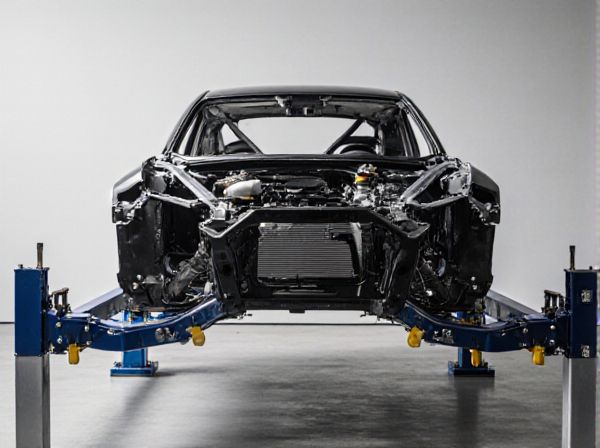
Photo illustration: Unibody vs Body-on-Frame
Unibody construction integrates the vehicle's body and frame into a single unit, providing enhanced rigidity, lighter weight, and improved fuel efficiency, making it ideal for everyday passenger cars. Body-on-frame design mounts the vehicle's body onto a separate frame, delivering superior strength and durability, which is beneficial for heavy-duty trucks and off-road vehicles. Understanding the differences helps you choose the right vehicle based on performance, comfort, and intended use.
Table of Comparison
| Feature | Unibody Frame | Body-on-Frame |
|---|---|---|
| Structure | Integrated body and frame | Separate body mounted on frame |
| Weight | Lighter, improves fuel efficiency | Heavier, reduces efficiency |
| Strength | Less durable under heavy loads | Highly durable, ideal for towing and off-roading |
| Safety | Better crash absorption and rigidity | Less effective crash energy management |
| Repair Cost | Higher due to integrated components | Lower, easier to repair separately |
| Common Use | Passenger cars, SUVs | Trucks, heavy-duty SUVs |
Introduction: Understanding Vehicle Frame Construction
Unibody and body-on-frame are two fundamental vehicle frame constructions that impact performance, durability, and safety. Unibody integrates the body and frame into a single structure providing improved fuel efficiency and handling, commonly used in passenger cars and crossovers. Body-on-frame separates the body from the frame, offering superior strength and off-road capability, preferred in trucks and large SUVs.
What is a Unibody Frame?
A unibody frame integrates the vehicle's body and chassis into a single, cohesive structure, enhancing rigidity and reducing overall weight. This design improves fuel efficiency and handling by distributing stress across the entire frame, unlike body-on-frame designs that rely on a separate chassis. Commonly used in passenger cars and crossover SUVs, unibody frames provide better crash safety and a smoother ride due to their structural efficiency.
What is a Body-on-Frame Structure?
A Body-on-Frame structure consists of a separate, robust steel or aluminum frame that supports the vehicle's mechanical components, with the body mounted on top. This design offers enhanced durability and is commonly used in trucks and off-road vehicles for better load-bearing and off-road capability. The frame absorbs stresses from rough terrain or heavy loads, protecting the body and improving vehicle longevity.
Key Differences Between Unibody and Body-on-Frame
Unibody construction integrates the vehicle's body and frame into a single cohesive structure, enhancing rigidity and reducing overall weight, which improves fuel efficiency and handling. Body-on-frame design features a separate chassis and body, offering superior durability and easier repairs, making it ideal for heavy-duty trucks and off-road vehicles. These structural differences significantly affect vehicle performance, safety, towing capacity, and manufacturing costs.
Performance and Handling Comparison
Unibody construction offers superior handling and ride quality due to its integrated chassis and body design, resulting in reduced weight and enhanced rigidity. Body-on-frame vehicles excel in performance for heavy-duty tasks, providing better towing capacity and durability on rugged terrains. Drivers prioritizing agile maneuverability and comfort typically prefer unibody models, while body-on-frame remains optimal for off-road stability and load-bearing strength.
Safety and Crashworthiness Analysis
Unibody construction integrates the vehicle's frame and body into a single structure, enhancing rigidity and energy absorption in collisions, which significantly improves crashworthiness and occupant safety. Body-on-frame designs, while traditionally offering superior durability for heavy-duty impacts, often exhibit higher deformation in crashes due to separate frame and body components, potentially compromising passenger protection. Advanced safety systems paired with unibody structures generally result in better crash test ratings and reduced injury risk compared to body-on-frame vehicles.
Durability and Maintenance Considerations
Unibody construction integrates the vehicle's body and frame into a single, rigid structure, enhancing crash safety but often making repairs more complex and costly after severe damage. Body-on-frame vehicles separate the body and frame, allowing for easier repairs and replacement of damaged sections, contributing to greater durability in off-road or heavy-duty applications. Maintenance for unibody vehicles tends to focus on preserving structural integrity and rust prevention, while body-on-frame trucks require routine inspection of frame components for rust and alignment issues.
Off-Road vs On-Road Capabilities
Unibody construction offers enhanced on-road handling, ride comfort, and fuel efficiency due to its integrated body and frame design, making it ideal for everyday driving and light off-road use. Body-on-frame vehicles excel in off-road capabilities, providing superior durability, higher ground clearance, and better torsional rigidity, essential for rugged terrains and heavy towing. Choosing between unibody and body-on-frame depends on prioritizing either refined on-road performance or robust off-road toughness.
Common Vehicles Using Each Frame Type
Unibody construction is commonly found in modern sedans, hatchbacks, and crossover SUVs such as the Toyota Camry, Honda CR-V, and Subaru Outback, offering lighter weight and improved fuel efficiency. Body-on-frame designs are typically used in trucks, large SUVs, and off-road vehicles like the Ford F-150, Jeep Wrangler, and Toyota Land Cruiser, providing superior durability and towing capacity. These structural differences influence vehicle performance, safety, and intended usage across various automotive segments.
Which is Better: Unibody or Body-on-Frame?
Unibody construction offers superior fuel efficiency, handling, and safety by integrating the body and frame into a single structure, making it ideal for passenger cars and crossovers. Body-on-frame designs provide enhanced durability, off-road capability, and easier repair, preferred in trucks and SUVs for heavy-duty and rough-terrain applications. The choice between unibody and body-on-frame depends on the vehicle's intended use, with unibody excelling in everyday driving comfort and body-on-frame excelling in ruggedness and towing capacity.
 caratoz.com
caratoz.com